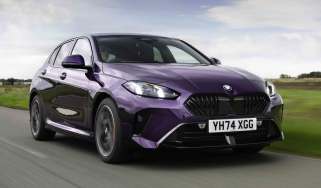Used BMW 1 Series review: 2011 to 2019 (Mk2) - Interior, comfort and safety
The BMW 1 Series’ interior is smart, well made and has plenty of tech, which helps to justify its premium price
Inside, the BMW 1 Series follows a similar driver-focused template to the company’s larger cars. The first-generation 1 Series was let down by its scratchy and mixed plastics, but the Mk2 model was a big improvement and the 2015 update made it even better.
It feels special behind the wheel, too, with an upmarket ambience. The front seats are mounted low to the floor for a sportier feel but visibility is decent, with no major blind spots, even when performing tricky manoeuvres.
What’s the BMW 1 Series like inside?
Excellent forward visibility means the BMW is easy to place on the road, and it feels compact when driving on tight car-park ramps, squeezing down country lanes or parking in small parallel spaces. Still, the rear window is quite narrow, and with three passengers sitting in the back you’ll definitely be relying on your door mirrors to see what’s coming up behind.
The seats offer good support and will hold you firmly in place even if you decide to drive the 1 Series quickly. There’s a wide range of adjustment, too, so with a bit of tweaking most drivers will be able to find a comfortable position, although this process might take a bit longer than it would in the Audi A3.
More reviews
Car trim reviews
In-depth reviews
- BMW 1 Series review – the keen driver’s premium hatchback pick
- BMW M135i review – a fast and practical hot hatch, but lacks character
- BMW 1 Series coupe (2008-2014)
Road tests
Used car reviews
Most of the 1 Series’ dashboard is covered in dark, black plastic, but pick one of the sportier trim levels and you’ll get brushed aluminium or coloured inserts that give the BMW a little more style. However, these models also come with black headlining, which makes the car feel a little cramped inside, even though it’s actually bigger than the first-generation model by quite a significant margin.
What’s on the equipment list?
The BMW SE model is the entry-level car and the cheapest BMW available. It comes with air-conditioning, alloy wheels, LED rear lights and a leather-trimmed steering wheel as standard, plus DAB and sat-nav.
In fact every 1 Series comes with sat-nav, a digital radio, and a 6.5-inch colour screen that’s controlled by a small wheel mounted on the centre console, with shortcut buttons that allow you to switch between menus with ease. Some models will have the optional ‘Professional’ upgrade that includes an 8.8-inch screen, hard-drive storage space for music and map data, 3D navigation and an uprated stereo.
Every 1 Series also offers access to BMW's 'remote services'. Here, vehicle information including fuel level can be checked using a smartphone app. It also enables you to operate certain functions remotely, such as the headlight flasher, ventilation and central locking.
Moving up to a Sport brings a longer list of equipment and additional sports styling niceties, while M Sport models have a bodykit and bigger alloy wheels, but it’s worth remembering some cars may have replaced the stiffer M Sport suspension with a standard and more comfortable set-up because it was a no-cost option from new.
How safe is it?
The BMW 1 Series picked up a five-star safety rating in its Euro NCAP crash tests, and was ranked among the best in its class for crash protection, with an adult occupant rating of 91 per cent and a child occupant rating of 83 per cent. Pedestrian protection was good, too – the 1 Series scored 63 per cent here, putting it close to the Audi A3 and Volkswagen Golf.
Plenty of safety technology was fitted as standard, including traction control, multiple airbags, Isofix child-seat mounts, anti-lock brakes and electronic stability control. There were also plenty of safety-related optional extras to look out for, such as lane-departure warning and automatic braking, which is able to detect stationary traffic in front of you and automatically brake to prevent a low-speed collision.














